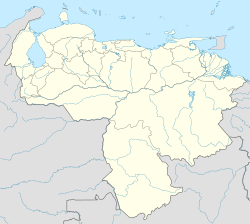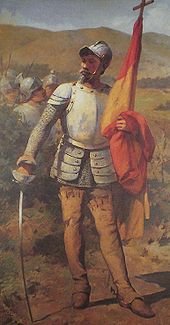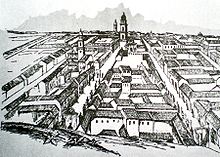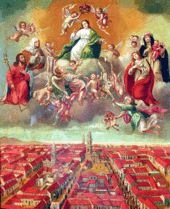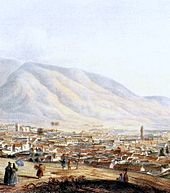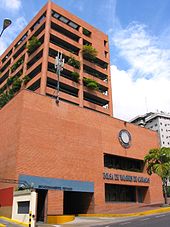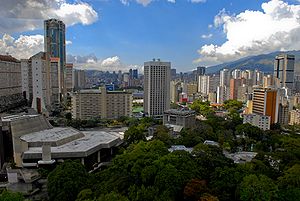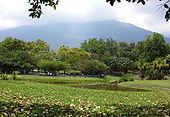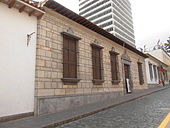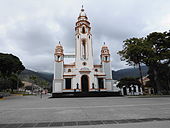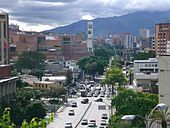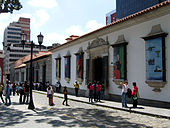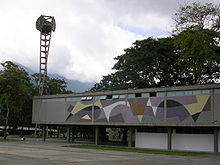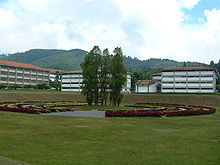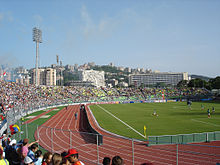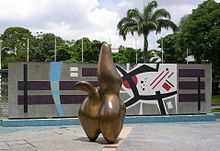
Caracas
Background to the schools Wikipedia
SOS Children, which runs nearly 200 sos schools in the developing world, organised this selection. SOS Child sponsorship is cool!
| Caracas | |||
|---|---|---|---|
| — City — | |||
| Some images from Caracas | |||
|
|||
| Nickname(s): La Sultana del Ávila (The Avila's Sultana) La Sucursal del Cielo (Heaven's Branch on Earth) "La Ciudad de la Eterna Primavera" (The City of Eternal Spring) |
|||
| Motto: Ave María Purísima, sin pecado concebida, en el primer instante de su ser natural | |||
|
|
|||
| Coordinates: 10°30′N 66°55′W Coordinates: 10°30′N 66°55′W | |||
| Country | |||
| State | Venezuelan Capital District Miranda |
||
| Municipality | Libertador | ||
| Founded | 25 July 1567 | ||
| Founder | Diego de Losada | ||
| Metropolitan | Municipalities: Libertador, Chacao, Baruta, Sucre, El Hatillo | ||
| Government | |||
| • Type | Mayor-council | ||
| • Body | Government of the Capital District / Mayorship of the Metropolitan District | ||
| • Chief of Government / Mayor | Jacqueline Faría / Antonio Ledezma | ||
| Area | |||
| • City | 433 km2 (167 sq mi) | ||
| • Metro | 810 km2 (310 sq mi) | ||
| Elevation | 900 m (3,000 ft) | ||
| Population (2011) | |||
| • City | 1,943,901 | ||
| • Density | 4,489.3/km2 (11,627/sq mi) | ||
| • Metro | 2,903,685 | ||
| • Metro density | 3,584.7/km2 (9,284/sq mi) | ||
| Demonym | caraqueño (m), caraqueña (f) | ||
| Time zone | VST ( UTC−04:30) | ||
| Postal code | 1010-A | ||
| Area code | 212 | ||
| ISO 3166 code | VE-A | ||
| Website | Capital District Metropolitan District | ||
| The area and population figures are the sum of the figures of the five municipalities (listed above) that make up the Distrito Metropolitano. | |||
Caracas (Spanish pronunciation: [kaˈɾakas]), officially Santiago de León de Caracas, is the capital and largest city of Venezuela; natives or residents are known as Caraquenians in English (Spanish: Caraqueños).
Caracas is located in the northern part of the country, following the contours of the narrow Caracas Valley on the Venezuelan coastal mountain range (Cordillera de la Costa). Terrain suitable for building lies between 760 and 910 m (2,493.44 and 2,985.56 ft) above sea level. The valley is close to the Caribbean Sea, separated from the coast by a steep 2200 m (7400 ft) high mountain range, Cerro El Ávila; to the south there are more hills and mountains.
El Distrito Metropolitano de Caracas (Metropolitan District of Caracas) includes the Distrito Capital and four other municipalities in Miranda State: Chacao, Baruta, Sucre, and El Hatillo. The Distrito Capital had a population of 1,943,901 as of 2011, while that of Distrito Metropolitano was estimated at 2,903,685 as of (2011).
History
At the time of its founding, more than four hundred years ago, the valley of Caracas was populated by indigenous peoples. Francisco Fajardo, the son of a Spanish captain and a Guaiqueri cacica, attempted to establish a plantation in the valley in 1562 after founding a series of coastal towns. Fajardo's settlement did not last long. It was destroyed by natives of the region led by Terepaima and Guaicaipuro. This was the last rebellion on the part of the natives. On 25 July 1567, Captain Diego de Losada laid the foundations of the city of Santiago de León de Caracas. The foundation −1567 – “I take possession of this land in the name of God and the King” These were the words of Don Diego de Losada in founding the city of Caracas on 25 July 1567. In 1577 Caracas became the capital of the Spanish Empire's Venezuela Province under Governor Juan de Pimentel (1576–1583).
During the 17th century, the coast of Venezuela was frequently raided by pirates. With the coastal mountains as a barrier, Caracas was relatively immune to such attacks – one of the reasons it became the principal city of the region. However, in the 1680s, buccaneers crossed the mountains through a little-used pass while the town's defenders were guarding the more often-used one, and, encountering little resistance, sacked and set fire to the town.
The cultivation of cocoa under the Compañía Guipuzcoana de Caracas stimulated the development of the city, which in 1777 became the capital of the Captaincy General of Venezuela.
An attempt at revolution to gain independence organized by José María España and Manuel Gual was put down on 13 July 1797. But the ideas of the French Revolution and the American Wars of Independence inspired the people, and on 5 July 1811, a Declaration of Independence was signed in Caracas. This city was also the birthplace of two of Latin America's most important figures of the Venezuelan War of Independence: Francisco de Miranda and " El Libertador" Simón Bolívar. An earthquake destroyed Caracas on 26 March 1812, which was portrayed by authorities as a divine punishment for the rebellion against the Spanish Crown. The war continued until 24 June 1821, when Bolívar gained a decisive victory over the royalists at the Battle of Carabobo.
As the economy of oil-rich Venezuela grew steadily during the first part of the 20th century, Caracas became one of Latin America's economic centers. During the 1950s, Caracas began an intensive modernization program which continued throughout the 1960s and early 1970s. The Universidad Central de Venezuela, designed by modernist architect Carlos Raúl Villanueva and declared World Heritage by UNESCO, was built. New working- and middle-class residential districts sprouted in the valley, extending the urban area towards the east and southeast. Joining El Silencio, also designed by Villanueva, were several workers' housing districts, 23 de Enero and Simon Rodriguez. Middle class developments include Bello Monte, Los Palos Grandes, Chuao, and El Cafetal. On 17 October 2004, one of the Parque Central towers caught fire. The dramatic change in the economic structure of the country, which went from being primarily agricultural to dependent on oil production, stimulated the fast development of Caracas, and made it a magnet for people in rural communities who migrated to the capital city in an unplanned fashion searching for greater economic opportunity. This migration created the rancho (slum) belt of the valley of Caracas.
Symbols
The flag of Caracas consists of a burgundy red field with the version of the Coat of Arms of the City (effective since the 1980s). The red field symbolises the blood spilt by Caraquenian people in favour of independence and the highest ideals of the Venezuelan Nation. Later, in the year 1994, presumably as a result of the change of municipal authorities, it was decided to increase the size of the Caracas coat of arms and move it to the centre of the field. This version of the flag is still in use today.
The coat of arms of the City of Caracas was adopted by the Libertador Municipality to identify itself. Later, the Metropolitan Mayor Office assumed the lion, the scallop and Saint James' Cross for the same purpose.
The anthem of the city is the Marcha a Caracas, written by the composer Tiero Pezzuti de Matteis with the lyrics by José Enrique Sarabia. The lyrics are said to be inspired by the heroism of the Caraquenian people, and the memory of the City of Red Roofs. Incidentally, the National Anthem of Venezuela, Gloria al Bravo Pueblo, includes the lines "...y si el despotismo levanta la voz, seguid el ejemplo que Caracas dio" ("...and if despotism raises its voice, follow the example that Caracas gave"), reflecting the fact that, in addition to generously providing many heroic fighters to the War of Independence, the junta established in Caracas (19 April 1810) served as inspiration for other regions to do the same—as did its declaration of independence a year later.
Local government
Caracas has five municipalities: Baruta, El Hatillo, Chacao, Libertador and Sucre. The constitution of Venezuela specifies that municipal governments be divided into executive and legislative branches. The executive government of the municipality is governed by the mayor, while the legislative government is managed by the Municipal council. In 8 March 2000, the year after a new constitution was introduced in Venezuela, it was decreed in Gaceta Official N° 36,906 that the Metropolitan District of Caracas would be created, and that some of the powers of these municipalities would be delegated to the Alcaldía Mayor, physically located in the large Libertador municipality, in the centre of the city.
Economy
Businesses that are located here include service companies, banks, and malls, among others. Most economic activity is in services, except some industries established in its metropolitan area. The Caracas Stock Exchange and Petróleos de Venezuela (PDVSA) are headquartered here. The PDVSA is the largest company in Venezuela, and negotiates all the international agreements for the distribution and export of petroleum. When the company existed, the airline Viasa had its headquarters in the Torre Viasa.
Caracas' central business district is Milla de Oro, which is located in the north of the Baruta municipality and the south of the Chacao municipality, it is one of largest financial districts of Latin America, it is home to many companies and is dominated by numerous high-rises. Other important business districts include Plaza Venezuela, Parque Central Complex and El Recreo.
Small and medium-size industry contributes to the Caracas economy. The city provides communication and transportation infrastructure between the metropolitan area and the rest of the country. Important industries in Caracas include chemicals, textiles, leather, food, iron and wood products. There are also rubber and cement factories. Its GDP(Nominal) is 69 billion $ and the GDP(PPP) per Capita is 24.000$
Cost of living
A 2009 United Nations survey reported that the cost of living in Caracas was 89% of that of its baseline city: New York. However, this statistic is based upon a fixed currency-exchange-rate of 2003 and might not be completely realistic, due to the elevated inflation rates of the last several years.
Geography
Caracas is contained entirely within a valley of the Venezuelan central range, and separated from the Caribbean coast by a roughly 15 km expanse of El Ávila National Park. The valley is relatively small and quite irregular, the altitude with respect to sea level varies from between 870 and 1,043 meters (2,854–3,422 ft), with 900 meters (2,953 ft) in the historic zone. This, along with the rapid population growth, has profoundly influenced the urban development of the city. The most elevated point of the Capital District, wherein the city is located, is the Pico El Ávila, which rises to 2,159 meters (7,083 ft). The main body of water in Caracas is the Guaire River, which flows across the city and empties into the Tuy River, which is also fed by the El Valle and San Pedro rivers, in addition to numerous streams which descend from El Ávila. The La Mariposa and Camatagua reservoirs provide water to the city.
Climate
Under the Köppen climate classification, Caracas has a Tropical savanna climate. Caracas is also intertropical, with precipitation that varies between 900 and 1,300 millimeters (35–51 in) (annual), in the city proper, and up to 2,000 millimeters (79 in) in some parts of the Mountain range. While Caracas is within the tropics, due to its altitude temperatures are generally not nearly as high as other tropical locations at sea level. The annual average temperature is approximately 23.1 °C (74 °F), with the average of the coldest month (January) 21.1 °C (70 °F) and the average of the warmest month (May) 25.0 °C (77 °F), which gives a small annual thermal amplitude of 3.9 °C (7.0 °F). In the months of December and January abundant fog may appear, in addition to a sudden nightly drop in temperature, until reaching 7 °C (45 °F) or less. This peculiar weather is known by the natives of Caracas as the Pacheco. In addition, nightly temperatures at any time of the year are much (12 to 16 °C) lower than daytime highs and usually do not remain above 20 °C (68 °F), resulting in very pleasant evening temperatures. Hail storms appear in Caracas, although only on rare occasions. Electrical storms are much more frequent, especially between June and October, due to the city being in a closed valley and the orographic action of Cerro El Ávila.
| Month | Jan | Feb | Mar | Apr | May | Jun | Jul | Aug | Sep | Oct | Nov | Dec | Year |
|---|---|---|---|---|---|---|---|---|---|---|---|---|---|
| Record high °C (°F) | 31.9 (89.4) |
34.1 (93.4) |
35.3 (95.5) |
33.5 (92.3) |
34.4 (93.9) |
32.8 (91) |
33.6 (92.5) |
31.5 (88.7) |
32.2 (90) |
31.4 (88.5) |
31.2 (88.2) |
30.8 (87.4) |
35.3 (95.5) |
| Average high °C (°F) | 23.3 (73.9) |
23.6 (74.5) |
24.3 (75.7) |
25.0 (77) |
25.8 (78.4) |
26.0 (78.8) |
25.5 (77.9) |
25.8 (78.4) |
25.5 (77.9) |
25.2 (77.4) |
24.6 (76.3) |
23.8 (74.8) |
24.87 (76.75) |
| Daily mean °C (°F) | 19.6 (67.3) |
19.7 (67.5) |
20.2 (68.4) |
21.2 (70.2) |
22.0 (71.6) |
22.0 (71.6) |
21.7 (71.1) |
21.9 (71.4) |
21.9 (71.4) |
21.8 (71.2) |
21.3 (70.3) |
20.2 (68.4) |
21.13 (70.03) |
| Average low °C (°F) | 15.9 (60.6) |
15.8 (60.4) |
16.0 (60.8) |
17.5 (63.5) |
18.2 (64.8) |
18.1 (64.6) |
17.9 (64.2) |
18.1 (64.6) |
18.3 (64.9) |
18.4 (65.1) |
18.0 (64.4) |
16.5 (61.7) |
17.39 (63.3) |
| Record low °C (°F) | 10.0 (50) |
10.9 (51.6) |
11.4 (52.5) |
12.5 (54.5) |
13.1 (55.6) |
14.9 (58.8) |
14.1 (57.4) |
14.3 (57.7) |
15.5 (59.9) |
13.1 (55.6) |
11.9 (53.4) |
10.0 (50) |
10.0 (50) |
| Rainfall mm (inches) | 15.3 (0.602) |
13.2 (0.52) |
11.4 (0.449) |
59.2 (2.331) |
81.7 (3.217) |
134.1 (5.28) |
118.4 (4.661) |
123.8 (4.874) |
115.4 (4.543) |
126.3 (4.972) |
72.6 (2.858) |
41.4 (1.63) |
912.8 (35.937) |
| Avg. rainy days (≥ 1.0 mm) | 6 | 4 | 3 | 7 | 13 | 19 | 19 | 18 | 15 | 15 | 13 | 10 | 142 |
| % humidity | 73.7 | 74.2 | 73.0 | 76.3 | 75.4 | 75.1 | 74.1 | 74.0 | 74.9 | 74.7 | 73.7 | 74.7 | 74.48 |
| Mean monthly sunshine hours | 229.4 | 217.5 | 235.6 | 183.0 | 182.9 | 183.0 | 210.8 | 217.0 | 213.0 | 210.8 | 210.0 | 213.9 | 2,506.9 |
| Source #1: Instituto Nacional de Meteorología e Hidrología (INAMEH) | |||||||||||||
| Source #2: World Meteorological Organization (rainfall data), Hong Kong Observatory (sun only), NOAA(extremes) | |||||||||||||
Landmarks
Federal Capitol
At the southwest corner of Plaza Bolívar is the edifice that belonged from 1637 to 1874 to the Conceptions Nuns monastery, and that from 19 April 1810 was the seat of the first congress. The southern part is the present seat of the National Assembly, and the northern part was formerly the Elliptic room, Triptic room and Shields room. It was built during the government of Antonio Guzmán Blanco.
East Park
The Caracas East Park (Parque del Este, now officially Parque Generalísimo Francisco de Miranda) was designed by Brazilian architect Roberto Burle Marx. It is a green paradise in the middle of the city, and it contains a small zoo. A replica of the ship led by Francisco de Miranda, the Leander, is being built in the southern part of the park. Before there used to exist a replica of the Santa Maria ship, used by Christopher Colombus in his voyages to America.
Teresa Carreño Cultural Complex
The Teresa Carreño Cultural Complex (Complejo Cultural Teresa Carreño), or more commonly the Teresa Carreño Theatre (Teatro Teresa Carreño), is by far the most important theatre of Caracas and Venezuela, where symphonic and popular concerts imagine frequently, operas, ballet and theatre. It is the second largest theatre in South America, after the Teatro Colón of Buenos Aires, Argentina.
Simon Bolivar birthplace house
Skyscrapers may loom overhead, but there is more than a hint of original colonial flavor in this neatly proportioned reconstruction of the house where Simon Bolivar was born on 24 July 1783. The museum's exhibits include period weapons, banners and uniforms.
Much of the original colonial interior has been replaced by monumental paintings of battle scenes, but more personal relics can be seen in the nearby Bolivian museum. Pride of place goes to the coffin in which Bolivar's remains were brought from Colombia; his ashes now rest in the National Pantheon.
National Pantheon
Venezuela's most venerated building is five blocks north of Plaza Bolívar, on the northern edge of the old town. Formerly a church, the building was given its new purpose as the final resting place for eminent Venezuelans by Antonio Guzmán Blanco in 1874.
Parque Central Complex
At a short distance east of Plaza Bolívar is Parque Central, a concrete complex of five high-rise residential slabs of somewhat apocalyptic-appearing architecture, crowned by two 56-storey octagonal towers, one of them is under repair due to the fire which burnt the building on 17 October 2004.
Parque Central is Caracas' art and culture hub, with museums, cinemas and the Teresa Carreño Cultural Complex. The West Tower balcony, on the 52nd floor, gives a 360° bird's-eye view of Caracas.
Public squares
- Plaza Bolívar is the focus of the old town with the monument to El Libertador, Simon Bolívar, at its heart. Modern high-rise buildings have overpowered much of the colonial flavor of Caracas' founding neighbourhood.
- Plaza Venezuela is the geographic centre of Caracas. It is a large urban plaza at the entrance of the Central University of Venezuela. Kinetic artists have displayed their works there, including Carlos Cruz-Diez, Alejandro Otero and Jesus Soto. East of the Plaza is the Plaza Venezuela Fountain, a large computerized display of water, music and colored light refurbished in 2009 to include the latest available technology.
- Plaza Caracas was constructed in 1983. It is in the Simón Bolívar Centre, at the foot of the 30-story towers, dominating El Silencio District and forming a unique testimony to the early days of the modernization of the city. It has various levels for pedestrian and motorised traffic, and contains the business, shops, restaurants, services of a zone in which are concentrated public and private institutions.
- Plaza San Jacinto is situated among the San Jacinto, San Pablo, El Chorro and Trapos's corners. Its history dates from 1603 and there used to be the market of the city. In the middle of the square, there was an Antonio Leocadio Guzmán statue and after which this place is called now "The Venezuelan". In the northwest part of the square is found the Sun's clock, made by Alexander Humboldt when he was in Caracas. In 1983, as part of the bycentenarial anniversary of Simón Bolívar, was built a black chambre. In 2010, as part of the celebration of the Bicentenary of the events of 19 April 1810, was inaugurated a steel obelisk.
El Hatillo
El Hatillo is a colonial town that is located at the south-east suburbs of Caracas in the municipal area of the same name. This small town, which is one of Venezuela's few well-preserved typical colonial areas, gives an idea of what Caracas was like in centuries past.
Cerro El Ávila
Cerro El Ávila (Mountain El Ávila) (Indigenous name: Guaraira Repano), is a mountain in the mid-North of Venezuela. It rises next to Caracas and separates the city from the Caribbean Sea. It is considered the lungs of Caracas because there is a lot of vegetation on it.
Las Mercedes
This zone contains restaurants with varied gastronomical specialties, along with pubs, bars, pools and art galleries.
Altamira neighbourhood
Altamira is a neighbourhood in the Chacao municipality of Caracas. It has its own Metro Station, many hotels, malls and restaurants, and is an important business and cultural centre. The Francisco de Miranda avenue (a major avenue in Caracas) and the Distibuidor Altamira (a congested highway exit) are both in Altamira.
Religious buildings
The Iglesia de San Francisco is of historical value. Bolívar's funeral was held here twelve years after his death. Here he was proclaimed Libertador in 1813 by the people of Caracas. The church has gilded baroque altarpieces, and retains much of its original colonial interior, despite being given a treatment in the 19th century under the auspices of Antonio Guzmán Blanco, which was intended to be modernizing. It contains some 17th century masterpieces of art, carvings, sculptures and oil paintings. The Central University of Venezuela, established during the reign of Philip V, was lodged for centuries in the church cloisters next door, which today are the seat of the Language Academy, and the Academies of History, Physics, and Mathematics.
The Caracas Cathedral is seat of Roman Catholic Archdiocese of Caracas.
The Mosque of Sheikh Ibrahim Al-Ibrahim is the second largest mosque in Latin America. For many years it was the biggest.
The Union Israelita de Caracas is the biggest Synagogue for the Jewish Ashkenazi community in Caracas. Its mission is to host the religious services and preserve the memory of the Jewish heritage in Venezuela. Similarly, Mariperez is the biggest Synagogue for the Jewish Sephardic community in Caracas.
Colleges, universities and international schools
Central University of Venezuela
The Central University of Venezuela (Universidad Central de Venezuela in Spanish) is a public University. Founded in 1721, it is the oldest university in Venezuela and one of the first in Latin America. The university campus was designed by architect Carlos Raúl Villanueva and it was declared World Heritage by UNESCO in 2000. The Ciudad Universitaria de Caracas, as the main Campus is also known, is considered a masterpiece of architecture and urban planning and it is the only university campus designed in the 20th century that has received such recognition by UNESCO.
Simón Bolívar University
The Simón Bolívar University (Universidad Simón Bolívar, in Spanish, or USB) is a public institution in Caracas, Venezuela, with scientific and technological orientation. Its motto is "La Universidad de la Excelencia" ("University of Excellence"). Nationally, Simón Bolívar University is a well known school with a high reputation in scientific and engineering careers.
International schools
- International Christian School
- Colegio Internacional de Caracas
- British School of Caracas
- Escuela Campo Alegre
Sports
There are professional Association Football, baseball and several other sports.
Professional teams include Deportivo Italia, Caracas Fútbol Club, SD Centro Italo Venezolano, Estrella Roja FC and Real Esppor Club. The Deportivo Italia has reached the semifinals of international tournaments such as the Copa Libertadores de America, while the Caracas Fútbol Club has reached the quarterfinals.
Baseball teams Tiburones de La Guaira and Leones del Caracas play in the Estadio Universitario de la UCV, of the Central University of Venezuela, with a capacity of 26,000 spectators.
Another baseball team started in Caracas: the Navegantes del Magallanes. It was moved to Valencia, Carabobo in the 1970s.
Association Football stadiums include:
- Estadio Olímpico de la UCV, with capacity of 30 000 spectators is seat of the Deportivo Italia and Caracas Fútbol Club.
- Brígido Iriarte stadium, with a capacity of 12 000 spectators (old seat of the Deportivo Italia and Caracas Fútbol Club, and seat of the Estrella Roja FC). The Caracas Fútbol Club opened its own stadium in 2005, Campo Deportivo Cocodrilos.
- Cocodrilos de Caracas plays in the Venezuelan professional basketball league. They play their games in the "Gimnasio José Beracasa" in the neighbourhood of El Paraíso.
Caracas is the seat of the National Institute of Sports and of the Venezuelan Olympic Committee.
Caracas hosted the 1983 Pan American Games.
Teams
- Association Football: Caracas Fútbol Club, Deportivo Petare, Atletico Venezuela, Estrella Roja Futbol club, Real Esppor Club.
- Baseball: Tiburones de la Guaira, Leones del Caracas.
- Basketball: Cocodrilos de Caracas.
Culture
Caracas is Venezuela's cultural capital, with many restaurants, theaters, museums, and shopping centers. The city is home to an array of immigrants from but not limited to: Spain, Italy, Portugal, the Middle East, Germany, China, and Latin American countries.
Museums, libraries and cultural centres
Caracas, has been a city with great cultural aspirations throughout the course of its history. Institutions such as the old Atheneum bear witness to this awareness. The National library holds a great amount of volumes, and affords abundant bibliographic information for the student of the discovery and independence of Venezuela. The museum of Colonial Art has on show an interesting exhibition of Venezuelan art from the periods previous to its independence with fountains, furniture, colonial courtyards etc. In the Fine Arts Museum are kept some archaeological finds with some good examples of precolombine pottery.
Since 1974, Caracas has had a Contemporary Art Museum, containing works representing the most important tendencies in contemporary art, and since 1982, counts with a Children's Museum, a privately managed museum foundation, with the purpose of teaching children about science, technology, culture and arts. The Natural Science Museum, has a rich collection of archaeological pieces from the native cultures, in these collections and in other no less important galleries (Raúl Santana Creole Museum, Transport Museum, the Coin Museum, Bolivarian Museum, Jacobo Borges Museum, Carlos Cruz-Diez Museum, Alejandro Otero Museum, Sacred Museum, etc.) the cultural aspirations of Caracas are more than evident.
Gastronomy
Caracas has a gastronomical heritage due to the influence of immigrants, leading to a choice of regional and international cuisine. There is a variety of international restaurants including American, French, Arabic, Italian, Spanish, Indian, Chinese, Peruvian, Japanese, Mediterranean and Mexican. The district of La Candelaria contains Spanish restaurants, resulting from Galician and Canarian immigrants that came to this area in the mid-20th century.
Transportation
- The Caracas Metro has been in operation since 27 March 1983. With 4 lines, 47 stations and about 10 more to be constructed. It covers a great part of the city and also has an integrated ticket system that combines the route of the Metro with those offered by the Metrobús, a bus service of the Caracas Metro. As well a Metrocable feeds in the metro.
- Buses are the main means of mass transportation. There are two bus systems: the traditional system and the Metrobús. The traditional system runs a variety of bus types, operated by several companies on normal streets and avenues:
- Autobus; large buses.
- Camioneta; medium size buses.
- microbus or camionetica; vans or minivans.
- IFE; train services to and from Tuy Valley cities of Charallave and Cúa.
- Simón Bolívar International Airport, the biggest and most important in the country is located outside the city, roughly 20 miles (32 km) from the downtown area.
- Caracas Aerial Tramway
- In March 2009 four of the five Caracas districts launched Plan Vía Libre to reduce traffic (the pro-Chavez Jorge Rodríguez' Libertador District is currently not cooperating as the other districts are in the hands of the opposition). On each weekday, cars with certain number plates are banned from entering key parts of the city centre; the numbers rotate so that any particular car is banned one day a week.
International relations
Caracas is twinned with:
|
|
|
Districts
|
|||||||||||||||||||||||||




